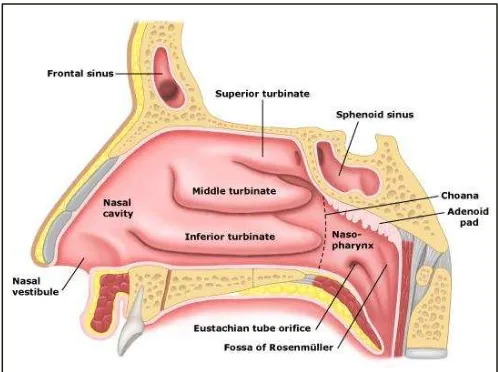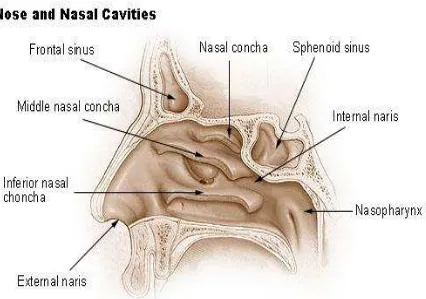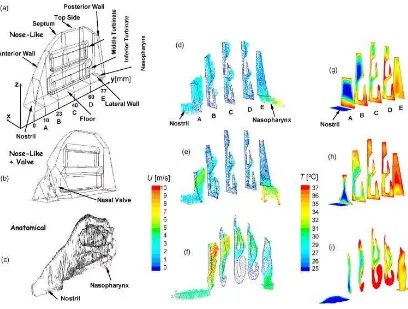FLOW MODELLING OF SIMPLIFIED HUMAN NASAL CAVITY
MUHAMMAD HAFIZ BIN ABD RAHIM
i
SUPERVISOR DECLARATION
“I hereby declare that I have read this thesis and in my opinion this report is sufficient in terms of scope and quality for the award of the degree of Bachelor
of Mechanical Engineering (Thermal Fluids)”
ii
FLOW MODELLING OF SIMPLIFIED HUMAN NASAL CAVITY BY USING COMPUTATIONAL FLUID DYNAMICS (CFD)
MUHAMMAD HAFIZ BIN ABD RAHIM
This report is submitted in the fulfillment of the requirements for the award of a bachelor's degree in mechanical engineering (Thermal Fluids)
Fakulti Kejuruteraan Mekanikal Universiti Teknikal Malaysia Melaka
iii
DECLARATION
“I hereby declare that the work in this report is my own except for summaries and quotations which have been duly acknowledged.”
iv
v
ACKKNOWLEDGEMENT
I would like to express my deepest appreciation to all those who provided me the
possibility to complete this report. A special gratitude I give to our final year
supervisor, Ms. Nur Hazwani binti Mokhtar, whose contribution in stimulating
suggestions and encouragement, helped me to coordinate my project especially in
writing this report.
Furthermore I would also like to acknowledge with much appreciation the crucial
role of the staff of Uniersiti Teknikal Malaysia Melaka (UteM), who gave the
permission to use all required equipment and the necessary materiasl to complete
the task need upon completing my research. A special thanks goes to my team mate,
Fakhrurazi,Azarul,Idham and Kismera who help me by giving suggestions on how
to complete my simulations. Last but not least, many thanks go to the head of the
project, Ms. Nur Hazwani whose have invested his full effort in guiding the team in
achieving the goal. I have to appreciate the guidance given by other supervisor as
well as the panels especially in our project presentation that has improved our
vi
ABSTRACT
Nasal cavity is a main part of the respiratory system. The understanding on
how its works and the flow behavior may help medical practitioners to come out with
a new dignose or treatment. Therefore, the objective of this study is to analyse the
airflow in a simplified three dimensional (3D) model of human nasal cavity. By
using Computational Fluid Dynamic (CFD) analysis, a simplified 3D model is to be
simulate by using FLUENT. The simulation shows a good result of velocity inside
the nasal cavity, the airflow pattern and the pressure drop throughout the nasal
cavity. The Result obtained is also being compared to the actual 3D model done by
previous researchers for validation purposes. The simplified 3D model performs well
during the simulation process and were able to simulate the airflow inside the nasal
cavity either inhalation or exhalation process. The study fullfill its objective to
vii
ABSTRAK
Rongga hidung merupakan bahagain penting bagi sistem pernafasan manusia.
Dengan memahami bagaimana ianya berfungsi, para pengamal perubatan boleh
memperkenalkan cara rawatan yang lebih cekap bagi pesakit. Tujuan kajian ini
dibuat adalah untuk mengkaji lairan di dalam model 3 Dimesional (3D) ringkas
rongga hidung manusia. Dengan menggunakan kaedah Perkomputeran Dynamic
Bendalir (CFD), model 3D ringkas rongga hidung akan disimulasikan menggunakan
perisian FLUENT. Simulasi telah menunjukan keputusan yang baik dari segi halaju,
corak aliran serta penurunan tekanan di dalam rongga hidung tersebut. Keputusan
yang diperoleh telah dibandingkan dengan keputusan-keputusan yang didapati oleh
pengkaji-pengkaji sebelum ini. Disebabkan model 3D ringkas ini telah berjaya
mengsimulasikan keadaan di dalam rongga hidung secara tepat, maka objecktif
viii
TABLE OF CONTENTS
CHAPTER TITLE PAGE
SUPERVISOR DECLARATION i
DECLARATION iii
DECDICATION iv
ACKNOWLEDGEMENT v
ABSTRACT vi
ABSTRACT vii
TABLE OF CONTENTS viii
LIST OF TABLE x
LIST OF FIGURES xi
CHAPTER 1 INTRODUCTION 1
1.0 INTRODUCTION 1
1.1 PROBLEM STATEMENT 3
1.1.1 Objective 3
1.1.2 Scope 3
CHAPTER 2 LITERATURE REVIEW 5
ix
2.1 SIMPLIFIED MODEL 7
2.2 PARAMETER STUDIED 9
2.2.1 Velocity 9
2.2.2 Airflow 9
2.2.3 Pressure 10
CHAPTER 3 METHODOLOGY 11
3.0 INTRODUCTION 11
3.1 FLOW THEORY 12
3.2 MODEL RECONSTRUCTION 13
3.3 BOUNDARY CONDITION 16
3.4 MESH 17
3.5 SIMULATION FLOWCHART 19
3.6 VALIDATION 20
CHAPTER 4 RESULT AND ANALYSIS 23
4.0 RESULT 23
4.1 FLOW PATTERN 23
4.1.1 Flow Pattern during Inhalation 24
4.1.2 Flow Pattern During Exhalation 29
4.2 VELOCITY AND PRESSURE 33
4.2.1 Resistance 33
4.2.2 Velocity 24
4.2.3 Pressure 35
4.3 DISCUSSION 36
CHAPTER 5 CONCLUSION AND RECOMMENCDATION 37
5.0 CONCLUSION 37
x
LIST OF TABLE
NO. TITLE PAGE
3.1 Boundary Conditions 16
4.1 Comparison of the airflow pattern between simplified and
actual model 25
4.2 Comparison of the airflow pattern between simplified and
xi
LIST OF FIGURES
NO TITLE PAGE
2.1 Front view of the human nasal cavity 6
2.2 : Side view of the human nasal cavity 6
2.3 Graphical visualisations of turbinates inside human nasal
cavity 7
2.4 The example of simplified 3D model from David Elad study8
3.1 Navier-Strokes equation and the continuity equation 12
3.2 The dimension of the simplified model of human nasal
cavity 14
3.3 Simplified model of human nasal cavity 14
3.4 Dimension of the simplified 3D model 15
3.5 The simplified 3D model meshing 17
3.6 Meshing of the simplified model (Side view) 17
3.7 Meshing of the simplified model (Front view) 18
3.8 Meshing of the simplified model (Top view). 18
3.9 Simulation flow chart 19
3.10 The comparison of the cross-sectional area between the
xii
NO TITLE PAGE
3.11 Pressure drop Vs. Flow rate compared with previous
research 22
4.1 Re-circulatory Region in the flow pattern of a
simplified 3D human nasal cavity 26
4.2 Recirculatory flow at section A 26
4.3 Recirculatory flow at section B 27
4.4 Recirculatory Region in the actual 3D model of human
nasalcavity. 27
4.5 Recirculatory flow at section C 28
4.6 Recirculatory flow at section D 28
4.7 Exhalation air flow pattern in simplified 3D human nasal
cavity model(Side View)
4.8 Exhalation air flow pattern in simplified 3D human nasal
cavity model (Side View) 30
4.9 Re-circulatory flow in section E 30
4.10 Re-circulatory flow in section E 31
4.11 Resistance value between inhalation and expiration 33
4.12 Tabulation of velocity along the axial distance in the nasal
cavity at 5L/min 34
xiii
LIST OF APPENDIX
1
CHAPTER 1
INTRODUCTION
1.0 INTRODUCTION
The nasal cavity is one of the main components in a human nasal cavity
[Mazumdar, 1992]. The ability to humidify and heats inspired air to match the
body-core temperature is one the many function of the human nasal cavity [Mazumdar,
1992]. It also filters smokes and pollutants from reaching and hurting the lungs or
any other delicate organs/components in a human respiratory system. Several
significant sections in human nasal cavity are nasal valve, turbinates region and the
nasopharynx. The study on the human nasal cavity is becoming more popular due to
the fact that understanding the flow inside the nasal cavity would lead to a better yet
accurate diagnose and treatment scheme. Since 1950, studies on the human nasal are
beginning to rise [Proetz, 1953] and [Stuiver, 1958]. This is then followed by the
studies of trajectory fluid in the nostril using cinematographic techniques by Massing
[Masing, 1967]. Most of these studies were done to resolve problems that involve the
complex geometry of the nasal cavity together with their small size.
Throughout the years, there are a few studies on nasal cavity using analytical
2
This is mainly because the cost and time constraint that had to be consider by most of
the researcher. Therefore, using Computational Fluid Dynamics (CFD) software will
reduce these constraints with a better result. By using CFD, there are two types of
model that being used in the study of human nasal cavity. It is either an actual three
dimensional (3D) model or a simplified 3D model. A simplified model is a model
constructed based on the actual 3D model without the specific detail. According to
Zubair et al, a simplified model is constructed based on several actual models
[Zubair (2010)].
The pattern of the flow inside a human nasal cavity still obeys the basic fluid flow
laws [Mazumdar, 1992]. This characteristic is what enables the application of CFD
to predict and investigate the flow behaviour and patterns inside the human nasal
cavity. Past researchers show that the flow behaviour inside a human nasal cavity can
be predicted by using CFD analysis. This is confirmed by Mylavarapu et al that uses
both experimental and CFD analysis and compared both of the results obtained
[Mylavarapu, 2009].
Therefore the main objective of this study is to analyse the airflow inside a simplified
3
1.1 PROBLEM STATEMENT
Bio fluid mechanics, a study that relate both medical and engineering in one
point of view [Zubair,2010]. The study help doctors to came out with a better way of
diagnose and treatment for a patient. Nasal cavity is an important component to the
respiratory system [Mazumdar,1992,Zubair,2010].
Studies on the airflow in the human nasal cavity using an actual 3D model are
currently rising. However, because of a few limitation and constrains, the actual 3D
modelling are patient-specific thus limiting the data acquired to be used on a
different patient. Therefore, this study uses the simplified model of the human nasal
cavity to overcome these limitations. The objective of this study is to analyse the
characteristic of airflow in the human nasal cavity using a simplified 3D model.
1.1.1 Objective
The objective of this research is to analyse the airflow in a simplified 3D model of a
human nasal cavity.
1.1.2 Scope
This research will have a few scopes in order to achieve the objective given.
First of all, during the research, a simplified 3D model of a human nasal cavity will
be reconstructed. This model will be used throughout the research as the main
platform of the research. Then, the simplified 3D model is simulated using CFD
4
breathing condition of a normal human. Based on previous study [Zubair,2010],
there are 3 different flow rates measured in litre per minute (lpm) which are 15 lpm
5
CHAPTER 2
LITERATURE REVIEW
2.0 ANATOMY OF HUMAN NASAL CAVITY
Human nasal cavity is a crucial part in the respiratory system. It helps in
heating and humidifying inspired air to match the body-core temperature. It also
filters potential harmful substances from entering the airway [Zubair,2010]. Nasal
cavity consists of 3 main parts which are nasal valve, turbinate region and
nasopharynx.
Nasal valve serve as the inlet of the nasal cavity. This sections contains nasal
hair functioned to trap unwanted particles or substances in the inhaled air
[Mazumdar, 1992].
Turbinates is one of the crucial components existed in nasal cavity. These spongy
bones in the nasal cavity exist to protect the inner nasal anatomy [Mylavarapu,
2010]. The common function of turbinates is for the airflow control inside the nasal
cavity [Clemente, 1985].Turbinate can be divided into 3 major parts which is inferior
turbinates, middle turbinates, and superior turbinates. [Mylavarapu, 2010]. Inferior
turbinates is the largest turbinates in a turbinates region. The inferior turbinates is
6
inhaled air. Middle turbinates are smaller than inferior turbinates serves as a
protection to shield sensitive sinuses from direct exposure of the incoming
pressurized airflow. Superior turbinates is the smallest turbinates and it is connected
to the middle turbinates by the nerve endings. Middle turbinates functioned to control
the airflow in order to protect the old factory bulb.
Nasopharynx, located in the end of the nasal cavity connects the back of the
nose to the back of the mouth, according to cancerresearchuk.org. The function of
nasopharynx is to direct the air into the trachea after it passes through nasal cavity.
According to a research done by C. Xu, the pharyx area is the area that has the
highest pressure drop in a minimum area [Chu, 2006]. Usually, the velocity or air in
[image:20.595.209.452.319.504.2]this particular region is high compared to the other region [Clemente, 1985]
Figure 2.1 Front view of the human nasal cavity. (Source: Painneck.com)
[image:20.595.207.456.549.735.2]7
Figure 2.3: Graphical visualisations of turbinates inside human nasal cavity.
(Sorce :wikipedia)
2.1 SIMPLIFIED MODEL
By referring to Appendix A, the matrix of journals, all the researches that are
listed there were using an actual model. An Actual model is the model that is
generated by using data from an actual human specimen. The actual model, or
sometimes also referred as anatomical 3D model are used because of the accuracy of
the data are more valid. This is proven in many studies such as Zubair et al , Catro
Ruiz et al, Proetz,and Stuiver, but the actual model is only valid on a certain patient,
8
The construction of a simplified 3D model of human nasal cavity helps to
eliminate the limitation by assuming the average size of patient. This way, the 3D
model could be used to simulate the airflow inside every patient generally, without
[image:22.595.116.524.190.499.2]having to generate a new model.
Figure 2.4 The example of simplified 3D model from David Elad study.
9
2.2 PARAMETERS STUDIED
2.2.1 Velocity
Velocity is one of the parameters that we need to observe in the study.
Velocity has a significant impact on the nasal cavity and the respiratory Studies like
P Castro Luiz [Castro Luiz, 2005] and Shigeru Ishikawa [Ishikawa, 2006] focused
more on velocity inside the nasal cavity. For example, if the velocity of air is high
inside the superior turbinate, the sensitive sinus could be damaged and would lead to
the in ability to smell.There are few areas in the nasal cavity that varies in velocity
distribution. K. Hemtiwakorn [Hemtiwakorn, 2009] states that the velocity
distribution on both set of nasal cavity differs due to the uniqueness of the human
nasal cavity geometry. Since K. Hemtiwakorn uses an actual model, the variations on
the velocity distribution could be seen in his results.
2.2.2 Airflow
Usually in most cases/studies, the airflow pattern is plotted so that it could be
analysed and the behaviour of the flow could be predict. Studies like Zubair [Zubair,
2010] and Vizy Nazira [Nazira, 2010] shows the flow pattern inside the human nasal
cavity. Since the flow pattern is affected by the velocity in that particular area, it also
fluctuates and has different values when compared with the other set of nasal cavity
(left and right). Airflow pattern can also help researcher to to track particle easily just
by looking at the pattern. It is important to understand how particles moves inside a
10
2.2.3 Pressure
Another important parameter that needs to be studied in the nasal cavity is pressure.
A significant amount of pressure drops occurs inside the nasal cavity, especially in
the nasal valve area during inhalation process. Zubair et al states that the pressure
will affect a numbers of parts in the nasal cavity, for example, the vestibule region
[Zubair, 2010]. The pressure drop across the nasal cavity is important to be
monitored. The pressure drop that is less than a normal pressure drop indicates that
inability to breathe properly. Zubair et al states that the high pressure will exert
higher stress on the nasal wall that can affect the cell linings and bllod vessel along


